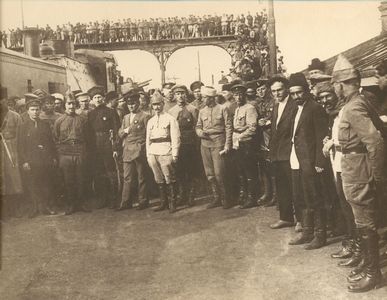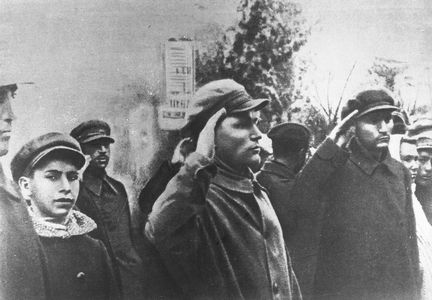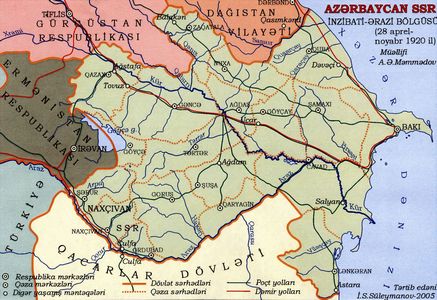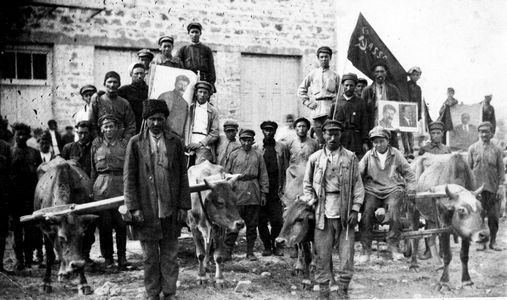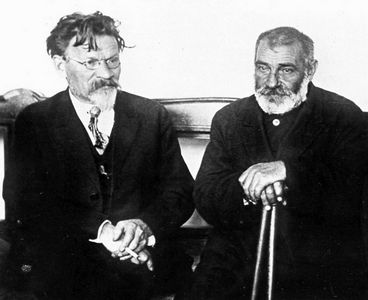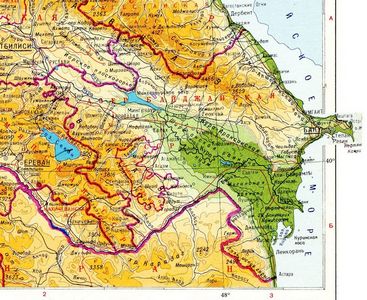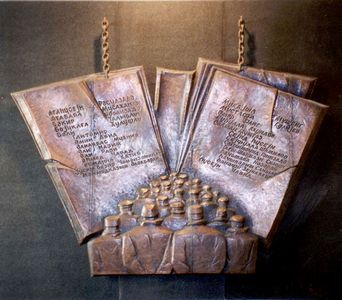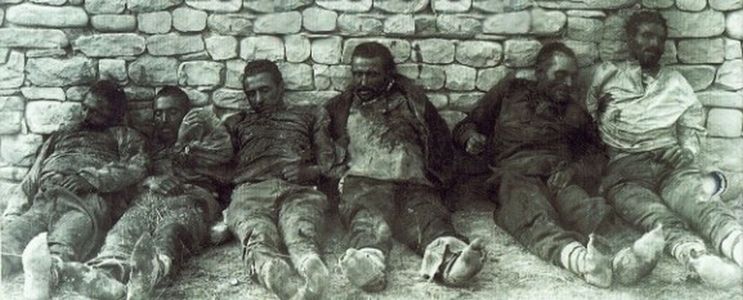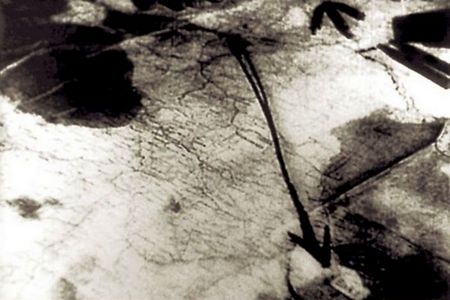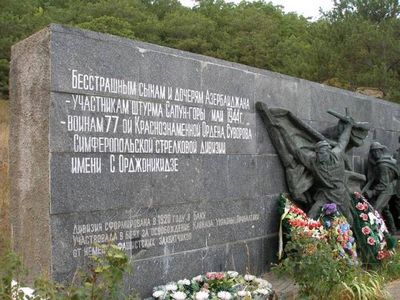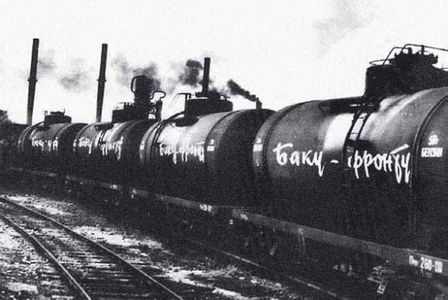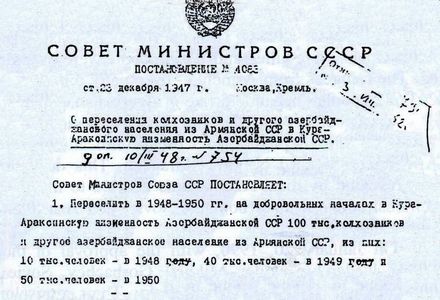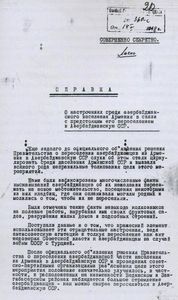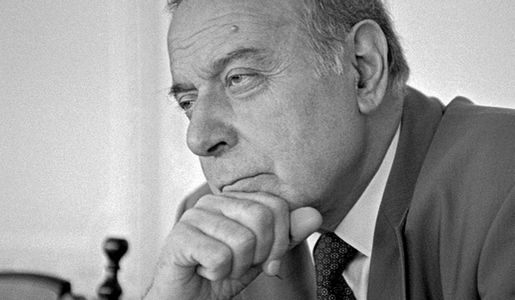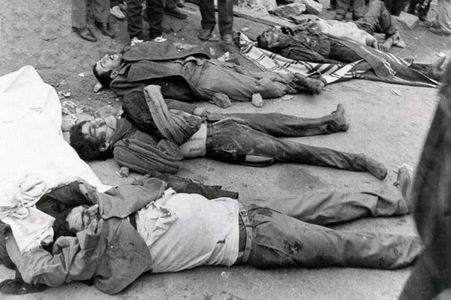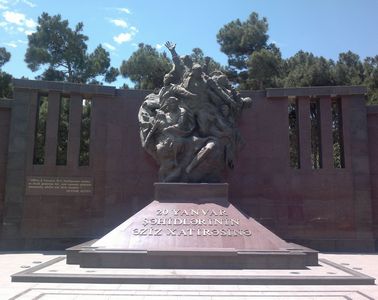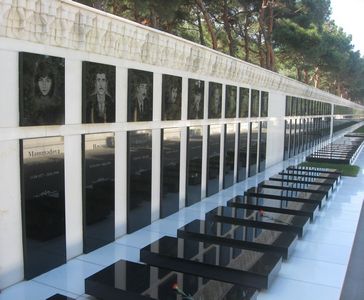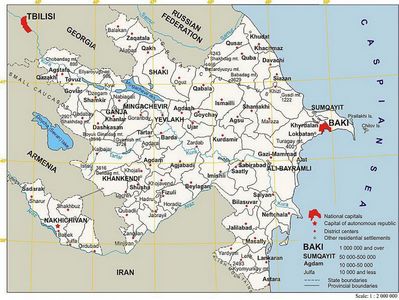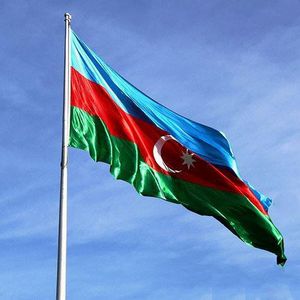1920
- Liquidation of the independence of Azerbaijan (27.04 - intrusion of armies of the Soviet Russia into Azerbaijan; 28.04 - fall of the Azerbaijan Democratic Republic; formation of puppet (marionette) state - the Azerbaijan Soviet Socialist Republic)
- Liquidation of Azerbaijan national statehood (replacement of the state symbols, the state language, the persecution of national cadres, either physical destruction or forced emigration of political, public, military figures of Azerbaijan)
- Violation of territorial integrity of Azerbaijan (30.11 - official transfer of Zangezur to Armenia)
- Repressions against national forces (a severe suppression of the started 22.05 Gandja, Karabakh, Nakhchivan, Zangezur revolts. Death of more than 20, 000 Azerbaijanis during repressions in 1920-1921).
1922
- Liquidation of nominal statehood of Azerbaijan (13.12 - Azerbaijan together with Georgia and Armenia formed a part of the Trans-Caucasus Soviet Federated Socialist Republics). Though the proclamation of people’s equality of Trans-Caucasus Federated Socialist Republics, for 15 years of existence of this state, none of Azerbaijanis had been appointed to the position of the first as well as the second secretary.
- Another violation of territorial integrity of Azerbaijan: attempts to seize Karabakh and Nakhchivan from Azerbaijan. 07.07.1923 -establishment of the Nagorno-Karabakh Autonomous Region. 09.02.1924 -establishment of the Nakhchivan Autonomous Soviet Socialist Republic.
- Struggle against national traditions and customs, the replacement of alphabet, the beginning of repressions against the opponents of forced collectivization.
1937
Since the establishment of Soviet power in Azerbaijan the repressions have been continued on political grounds. In 1920-1934 as the “counter-revolutionaries” were subjected to repression over than 300,000 people, in 1934-1939 – under the name “Pan-Turkist”, “Pan-Islamist”, “the bourgeois nationalist” were subjected to repression 27,458 people. From 02.02.1930, began repressions against opponents of collectivization: in 1930 - 1938, over 20,000 peasants were exiled to Central and Middle Asia. Since 1937, the repression gained the character of the planned actions of mass destruction.
That year, according to the decree of the Central Committee of the All-Union Communist Party for each region of USSR were determined quotas of repressions. Azerbaijan’s quota was determined on 10.07.1937: 1, 500 people - to be executed by firing, 3,750 people – to be sent in exile, 150 family of “enemies of nation” – to be sent in special camps. 31.01.1938 the quota was changed - for three months 2,000 people - must be executed by shooting, 1,000 – must be convicted. Because of welcomed of repression exceeding quotas, already in 1937, 2,215 people were shot, 2,846 people were arrested.
Despite of to local “troyka”s (literally “triples” – special courts) in the republic operated a special group of the Supreme Court of the USSR, considering 40-50 cases per a day. In 1920-1949, totally in Azerbaijan 300,000 people (out of them over 70, 000 people in1939-1949) were condemned on for political grounds; out of them over 29,000 were representative of intelligentsia.
To repressions were subjected Azerbaijanis living in Georgia and Armenia. Most of the Azerbaijanis in Dagestan have been exiled to Central Asia as well. Against Azerbaijanis who came from the South Azerbaijan but residing in Azerbaijan SSR acted decree “On the extension of repression among population based on national ethnicity”, and on its basis in September and December 1938, 18,000 Azerbaijanis were sent in exile either to Kazakhstan or sent to Iran. From October 1941 to November 1942, 35,000 Germans residing in Azerbaijan were sent in exile. From June 1949, were exiled citizens of Azerbaijan Assyrian, Greek and Turkish origin.
Stalinist repressions of 30 - 40s brought great losses of intellectual potential as well as demographics of Azerbaijan.
1945
In 1941-1945, over than 681, 000 Azerbaijanis fought against fascism, more than 300,000 died. In Azerbaijan was formed five national divisions. Azerbaijanis took an active part in partisan warfare and were actively involved in the anti-fascist movement. More than 400,000 Azerbaijanis were awarded with orders and medals of the USSR including other countries of antifascist bloc.
- During the war, the economy of Azerbaijan was an important constituent part of the economy of the USSR. Azerbaijan produced 70% of Soviet oil. The republic produced more than 130 types of military products, in 70 hospitals had been rendered help to the wounded.
1948
- On December 23, 1947 was published the edict of the Council of Ministers of the USSR “On the resettlement of collective farmers and other Azerbaijani population from the Armenian SSR to the Kura-Araz lowland of Azerbaijan SSR”. As the majority of Azerbaijanis deported from Armenia lived in mountainous regions, so resettlement to the Kura-Araz lowland couldn't get used to climate conditions, as a result thousands of people died. According to the decree, from 23 districts of Armenia 100,000 Azerbaijanis were subjected to voluntary resettlement, but in fact from 24 districts and Yerevan city (i.e. from over than 200 settlements) 144,654 Azerbaijanis were forcibly resettled. The Council of Ministers of the Armenian SSR was allowed to settle Armenians migrating abroad on the liberated buildings and dwelling houses from Azerbaijanis.
- Armenia began to rename settlements with Azerbaijani names, as well as close Azerbaijani educational and cultural institutions. In 1947-1953 were renamed 60 settlements lived Azerbaijanis. None of Azerbaijanis deported from Armenia, was not allowed to settle in Karabakh.
- In 1949 under the guise of internal migrations 132 Azerbaijani families (549 people) were resettled from Nagorno-Karabakh to Khanlar region (present Goygol), instead of them were settled Armenians.
- In 1989, the Soviet government of SSR adopted a decree to restore the rights of the deported people, but Azerbaijanis deported from Armenia in 1947-1953 were not included in this decree.
1969
In 1969, at the July plenum of the Central Committee of Azerbaijan Communist Party first secretary of the party, and therefore, the head of the republic, was elected Heydar Aliyev. In December 1982, Heydar Aliyev was elected the Member of the Political Bureau of the Central Committee of the Communist Party of the Soviet Union and was appointed the first deputy chairman of the USSR Council of Ministers.
- Progress in the socio- political, economic and cultural life of Azerbaijan in 1969- 1982 years was connected with the name of Heydar Aliyev. Heydar Aliyev, being in the framework of ideological epoch, prevented the destruction of the national spirit in Azerbaijan and at the same time used all the possibilities for its revival. When Heydar Aliyev came to power there were eliminated negative economic and cultural tendency leading to the collapse of the republic. 1969-1982 years by results of the implemented reforms and changes represented qualitatively brilliant years in the constructing annals of Azerbaijan. The way leading to the construction of Azerbaijan independence, in fact originates from 1969
-In October 1987, Heydar Aliyev in protest against the line pursued by the Political Bureau of the Central Committee of the Communist Party of the Soviet Union and personally by the General Secretary Michael Gorbachev had left all his positions. On October 3, 1993, as a result of nationwide vote Heydar Aliyev was elected the President of the Republic of Azerbaijan. In 1998 he was re-elected the President. In 2003, he agreed to take part in the presidential election, but due to his health problems, refused from elections. Heydar Aliyev died on December 12, 2003 in the U.S. Klivlend Clinic. He was buried in the Alley of Honor in Baku.
1990
- In 1990, on the night of January 19-20 the Soviet armed forces of the USSR had committed an act of terror against Azerbaijani people. The masses came out in the streets and expressed protest against the expansionist aspirations of Armenia and its protection by leadership of USSR, in fact people were striving for freedom and independence. Soviet empire, headed by Michael Gorbachev wanted to stop this desire
On January 19, M. Gorbachev roughly violated article 119 of USSR Constitution and article 71 of the Constitution of the Azerbaijan SSR (Soviet Socialist Republic), signed the decree about declaration “a state of emergency” on January 20, in Baku. Intrusion in Baku large contingents of the Soviet Army, armies of a special purpose and internal armies was accompanied by unprecedented cruelty. As a result of it in Baku were killed 134 civilian, more than 600 were wounded. Among killed there were representatives of five nationalities, as well as more than 20 women and children. People were fired with extreme cruelty and at close range. For example, Y. Meyerovich was shot 21 times, D. Khanmammadov more than 10 times, R. Rustamov 23 times. Hospitals, ambulances came under fire, doctors were killed, people were murdered with bayonets. Among them was B.Yefimtsev, who was blind in both eyes. Contrary to norms of international law the armies used the forbidden bullets of 5,45 mm caliber with the displaced centre of gravity.
However to subdue Azerbaijan people’s desire for freedom was impossible. In contravention to every interdictions of the empire the burial ceremony had the nationwide character, all republic enterprises went on striking for over 40 days which caused strong damage to the economy of the USSR and accelerated fall of M. Gorbachev’s regime. The Azerbaijan people demonstrated to the whole world the aspiration for freedom.
The crimes committed on January 20, 1990 by a military apparatus of soviet state against Azerbaijani people which went down in history as one of the worst crimes against humanity.
1991
- On October 18, 1991 at the session of the Supreme Council was adopted “Constitutional Act on the state Independence of the Azerbaijan Republic”. Constitutional Act of 6 chapters and 32 articles declared that the Azerbaijan Republic was recognized as the legal successor of the Azerbaijan Democratic Republic of 1918-1920. On December 29, 1991, the Constitutional Act was submitted to the national referendum and 95 % of the population taking part in the referendum voted for the independence and sovereignty. By this important document Azerbaijani people have achieved freedom in long-term struggle. Laws on the State Flag, State Emblem and National Anthem were adopted after the re-establishment of Azerbaijan independence.
- The Azerbaijan Republic soon after a declaration the independence began its activity in hard historical period. On the one hand, as a result of aggression of Armenians armed forces, Karabakh war took a large scale, on the other hand, as a result of misguided policy leading by people who came to power who were not very much aware of the current. As a result of internal political squabbles and separatism caused the threat of loss of independence. When Heydar Aliyev came to power he had a great deal of political experience, and this threat had been eliminated. Nowadays, the political and economic foundations of our independence getting stronger day by day. Nowadays maximum attention is paid to the strengthening of statehood, economic development and the preservation of national and moral values.
In the future - hard and glorious years of independence…
